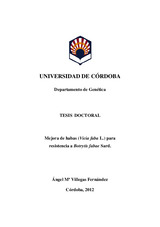Mostrar el registro sencillo del ítem
Mejora de habas (Vicia faba L.) para resistencia a Botrytis fabae Sard.
| dc.contributor.advisor | Rubiales, Diego | |
| dc.contributor.advisor | Sillero, Josefina | |
| dc.contributor.advisor | Ávila, Carmen | |
| dc.contributor.author | Villegas Fernández, Ángel María | |
| dc.date.accessioned | 2012-07-23T10:24:59Z | |
| dc.date.available | 2012-07-23T10:24:59Z | |
| dc.date.issued | 2012 | |
| dc.identifier.uri | http://hdl.handle.net/10396/7671 | |
| dc.description.abstract | En este trabajo se ha estudiado la resistencia de las habas (Vicia faba) a la botritis, enfermedad causada por el hongo Botrytis fabae. Se ha partido desde lo más general en mejora vegetal hasta abordar aspectos más específicos de la respuesta a la enfermedad. Así, mediante ensayos de campo en múltiples ambientes se han identificado genotipos con niveles interesantes de estabilidad en la resistencia. Se ha desarrollado un método para evaluación de la enfermedad en condiciones controladas, lo que ha permitido estudiar el efecto de la temperatura y de la edad del tejido del huésped en la evolución de la misma. Igualmente, se ha puesto a punto un protocolo para la observación microscópica de la interacción planta – patógeno mediante microscopía confocal. Por otra parte, se han dado los primeros pasos para la mejora asistida por marcadores, con la obtención de un mapa genético a partir de la F2 de un cruzamiento entre un genotipo resistente y otro susceptible. Sobre este mapa se ha localizado un QTL responsable del 40% de la resistencia. Asimismo se ha configurado el sistema Medicago truncatula / Botrytis spp. como modelo para V. faba / Botrytis spp., y se ha estudiado sobre dicho sistema modelo la influencia de la infección en la expresión de los factores de transcripción de la planta. Por último, se ha incrementado la calidad del material vegetal mediante la selección de genotipos resistentes no sólo a botritis, sino también a otra enfermedad de las habas, la roya. | es_ES |
| dc.description.abstract | In this work the resistance of faba bean (Vicia faba) to chocolate spot, a disease caused by the fungus Botrytis fabae, has been studied. It starts from generic plant breeding and reaches specific aspects of the response to the disease. Multi-environment field testing has allowed to identify genotypes possessing resistance with interesting levels of stability. A method for evaluating the disease under controlled conditions has been developed, which has permitted to assess the influence of temperature and the age of the host tissue on the evolution of the infection. Likewise a protocol has been optimised for the microscopic observation of the interaction plant – pathogen by means of confocal microscopy. On the other hand, the first steps towards marker-assisted breeding have been taken, and a genetic map of an F2 cross between a resistant genotype and a susceptible one has been obtained. A QTL responsible for the 40% of the resistance has been located on that map. The system Medicago truncatula / Botrytis spp. has been established as a model for V. faba / Botrytis spp., and the influence of infection on the expression of the transcription factors of the plant has been studied on that model system. Finally, the quality of the plant material has been increased by selecting those genotypes which are resistant not only to chocolate spot, but also to another disease of faba bean, rust | es_ES |
| dc.format.mimetype | application/pdf | es_ES |
| dc.language.iso | spa | es_ES |
| dc.publisher | Universidad de Córdoba, Servicio de Publicaciones | es_ES |
| dc.rights | https://creativecommons.org/licenses/by-nc-nd/4.0/ | es_ES |
| dc.subject | Mejora genética vegetal | es_ES |
| dc.subject | Haba | es_ES |
| dc.subject | Vicia faba | es_ES |
| dc.title | Mejora de habas (Vicia faba L.) para resistencia a Botrytis fabae Sard. | es_ES |
| dc.type | info:eu-repo/semantics/doctoralThesis | es_ES |
| dc.rights.accessRights | info:eu-repo/semantics/openAccess | es_ES |

